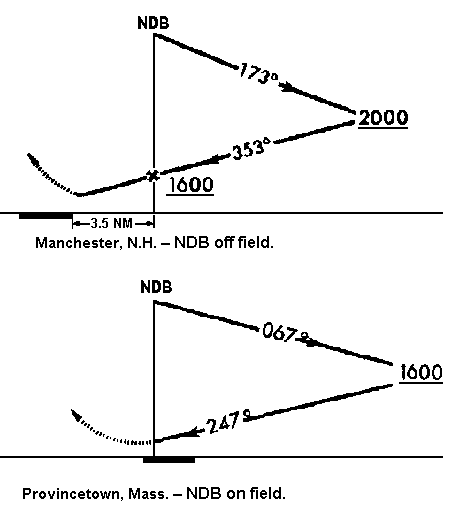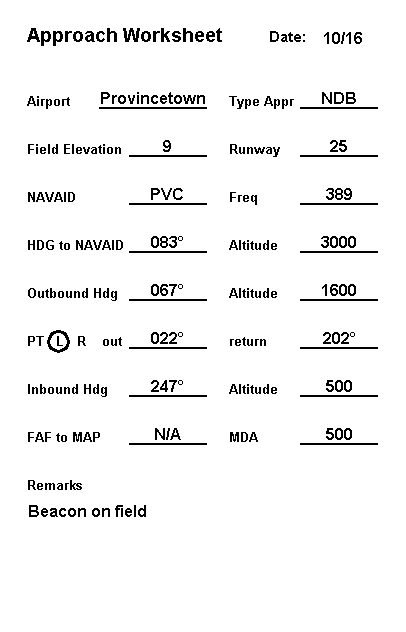NDB On Field

He called from Plymouth, Mass., from the plantation where the Pilgrims landed and settled. Said that the Pilgrims spelled it Plimoth, and who had the nerve to change the spelling?
I had no answer to that.
Worse, he went on, the Mayflower first landed at Provincetown, on Cape Cod, four weeks before it came to Plimoth. How come he never learned that in school?
I didn't have an answer for that either. Well, I did, but it would probably have cost me the charter.
They had some good history stuff in the museums over there in P'town, he went on. He wanted me to fly him over there in the morning. He had heard about the sailors on the Mayflower. They had cursed the Pilgrims all the way across the Atlantic for praying so much.
His kind of people, those sailors, Counter said. He wanted to learn more about those sailors. Never could understand how this country got started with people working the farms that wore tall black hats and big shiny buckles. Some of those sailors must have stayed behind.
"Hey," he finished, "any town that is so bad that the Pilgrims had to leave it? I gotta be there."
I was ready to hang up ... "One more thing," he hollered. "Don't get here too early. I'm helping a Holyoke student with her studies tonight—she's home alone for the weekend."
So much for the new leaf. I wanted to tell him that the professional wrestler's convention was in P'town this weekend, and they'd all be there. But it wasn't true.
I reached for my charts in the flight bag.
The Flight, KPYM to KPVC
It's a brief flight from Plymouth Municipal Airport to Provincetown: 13 to 15 minutes to the PVC beacon, the IAF. Smart to fly ... an hour and a half or so to drive out around the hooked arm of Cape Cod.
Print Provincetown's approach plate by clicking here.
Two significant differences are notable on Provincetown's approach plate vs. the ones used up 'til now. There is no FAF, and the table of times from FAF to the MAP is blank. Since the NDB is on the field, it can't be the Final Approach Fix, hence there can be no times for FAF to the MAP.
The next two figures compare the Manchester, N.H. approach plate (beacon off the field) with Provincetown's. The differences are immediately apparent. The Maltese Cross on Manchester's profile signifies the FAF—the Final Approach Fix, the last electronic fix before beginning the descent to MDA and the point that you should start timing for the missed approach point. There is no corresponding symbol on the Provincetown approach profile.

The Maltese Cross on the Manchester approach (top) signifies the FAF. Provincetown has no Maltese Cross, no FAF. The beacon is on the field.

Manchester, its beacon off the field, has an FAF, and FAF to MAP times. Provincetown's beacon is on the field, no FAF, and no FAF to MAP times.
Despite Mr. Counter's plea not to depart early, we're ready to go at 8:00 a.m. Provincetown has some low-lying fog and clouds with calm winds. Set your Flight Simulator weather at two miles visibility and a ceiling of 800 ft.
Begin, as usual, by completing the approach worksheet.
We'll take-off from Plymouth's runway 6 and have been approved for an NDB approach to Provincetown's runway 25. For this very short flight we've been assigned to 3000 ft. cruise altitude. Tune your ADF to PVC NDB, 389. On takeoff fly direct to PVC NDB.

Provincetown Airport Approach Worksheet
Descend to 1600 ft. approaching the PVC beacon. Cross the beacon, start the panel timer and intercept the 067° outbound bearing ... ADF needle will point to 247°. Maintain this track for two minutes, adjusting the heading as necessary for any wind. At the two-minute point, make the 45° left procedure turn, to a heading of 022°.
It's your choice whether to reset the timer or not at this time. Continue on the procedure-turn heading for one to two minutes, then reverse back to 202° with a right turn. The aircraft should be in the landing configuration at this point. Slow to 75 kts., and drop one notch of flaps.
Intercept the inbound bearing of 247°, reset the panel timer, and immediately descend to the MDA of 500 ft. Although there is no FAF to MAP time, the timer will generally keep you appraised of your distance from the airport. You flew outbound for two minutes plus made a procedure turn away from the airport, so inbound time will be on the order of two and a half minutes.
At this point you have only three tasks: fly the aircraft at the MDA, sight the runway, and land. Don't clutter your mind with other things.
With no FAF to fly from, your only option is to forge ahead until the runway is sighted or until the ADF needle indicates station passage. This is not all bad because you are flying inbound to the beacon, to an increasingly accurate signal. Mind your heading and don't chase the needle.
The MAP is unmistakably clear: station passage.
Without a clear timing fix inbound, the non-FAF procedure has a built-in trap in that the outbound leg (on the way to the procedure turn) usually starts over the airport, not over a beacon a mile or three from the runway. Pilots who fly a normal two-minute outbound leg may wind up still letting down to MDA when they roar across the airport or else descending at a very rapid, unsafe rate when the problem is recognized.
The solution is simple: extend your outbound leg to three minutes so you'll have room to descend on the way back to the airport. As soon as it's legal, i.e., on course, inbound, head for the MDA; don't hesitate. Grinding along at MDA for an extra half-minute or so is not sinful; besides it gives you better odds on breaking out of the clouds and more time in level flight to look for the airport and make a rational decision about when to start down for the landing.
One final matter. On a non-FAF approach, the runway heading will never coincide with your inbound heading. Since the beacon is located on the field, it must be located to the side of a runway, not right in front of it where it would be a hazard. So there will be some last-minute jockeying in position to properly align the aircraft with the runway heading.
Fly this route several times until you're satisfied with the results. It's really a fairly simple approach.
Next, crank in a stiff crosswind of 20 kts. from 170°. This will shorten the flight across Cape Cod Bay and give you a serious crosswind to contend with during the approach. Enjoy the challenge.
This ends the NDB work. The next subjects are VOR navigation and VOR approaches. Press the VOR Navigation button below to move along.
Site best viewed at 600 × 800 resolution or higher.
© 1999 – 2008, Charles Wood.

